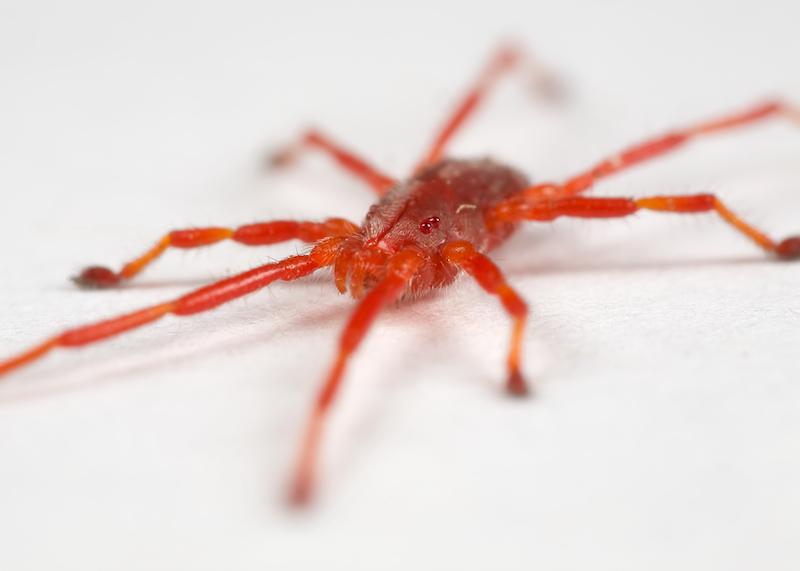Spider mites are a common garden pest. They destroy plants, robbing them of their colour and life. But with their small size and multiple egg sacs, they can be a real pain to get rid of. If you do find them, it’s a good idea to treat the problem quickly before spider mite populations get out of control. Learn more about spider mites, including how to get rid of them once and for all!
What Are Spider Mites?

Spider mites are tiny — about the size of a grain of pepper — so you’ll need to look closely to see them. Spider mites aren’t insects; they’re related to spiders, ticks, and harvestmen (daddy longlegs). They have eight legs and two body parts: the abdomen and the head. Spider mites come in different colours, including green, brown, red, yellow, and orange.
Spider mites will create webs between stems and over buds. This is a sure sign of spider mite infestation. Spider mites congregate in large numbers, so there should be a considerable amount of webbing if they are present.
How To Identify Spider Mite Damage?
Spider mite damage is often misidentified as herbicide damage or nutrient deficiency. The first sign of a problem is usually yellow spots on the upper surface of the leaf. These spots are due to chlorophyll loss caused by spider mite feeding. After a week or two of infestation, these spots will become larger and more numerous.
Spider mites thrive in warm weather and dry conditions and prefer bright light. However, they can survive in shady areas as well. If your plants seem to be dying for no reason, check with a magnifying glass for spider mites under the leaves.

If your infestation doesn’t look like the image above, you may have aphids.
How To Get Rid of Spider Mites?
Water
Spider mites hate water, so a good spray down with a strong stream of water will knock them off plants and reduce the population significantly.
Read more : The Best ZZ Plant Soil Mix Recipe for Healthy Plant Growth
Water the top and bottom of plant leaves to make sure you remove any webbing or egg sacks that may be present. Watering plants in the morning is best as this gives leaves time to dry before evening when temperatures drop and humidity rises.
Neem Oil
Neem oil is a proven pesticide that can not only kill the spider mites on contact, but it can also get rid of them for good. Neem oil is also non-toxic to humans, so you don’t have to worry about any long-term effects or side effects while using it.
Apply neem oil liberally with a spray bottle or garden sprayer to all parts of the plant, making sure to cover both sides of the leaves and stems. Spider mites thrive on the underside of leaves, so be sure not to skip this step.
Re-apply neem oil at weekly intervals until all signs of infestation have disappeared. If you re-apply too early, you may prevent new spider mites from hatching.
Insecticidal Soap
Insecticidal soap kills spider mites on contact and leaves a residue that keeps new ones from invading for 30 days or more. Spray the infected areas thoroughly until all the pests have been covered with soap.
Be sure not to use too much soap or it could burn the plant. Rinse off the soap after 15 minutes then follow up with another spray using plain water so that there is no leftover soap residue on the plant. You can buy insecticidal soap at many garden stores and online.
Alcohol
Spray your plants with alcohol to kill spider mites. Using 70% isopropyl alcohol is an effective way to get rid of spider mites. Simply spray your plant down with the alcohol and the spider mites will die off.
This method should be repeated every other day until you no longer see any signs of spider mites. For severe infestations, you can also use 100% pure grain alcohol. Just be sure to dilute it before you spray it on your plants, because it can burn them.
Horticultural Oil
Horticultural oil sprays are sold in concentrated form, which you’ll need to dilute before using. Follow the directions on the label carefully because mixing rates vary.
Read more : How to Make Aluminum-Free Baking Powder!
Spray the mixture on the tops and undersides of infested leaves as well as on branches and stems. Horticultural oil can be used safely on most ornamentals during any season of the year but avoid spraying it directly on blooms or buds because severe damage or death may occur.
Use the above products more effectively with Optic Foliar Transport for the best results.
Optic Foliar Transport will make any of the products above systemic. Making the plants only food source toxic to the bug and to the bug only. So the bug either has the option to eat the leaf and ingest the poison and die or starve to death. By using Optic Foliar Transport, you ‘ll able to use less and get much more effective results.

Optic Foliar EVIOS
Say good bye to residuals and odours when combating bugs with a Optic Foliar EVIOS. A new style of natural bug spray that utilizes non traditional plant extracts to make your garden pest free. Our non oil based no odour solutions combats a wide variety of pests while also allowing you to apply in full sunlight without having to spray the undersides of leaves. The only late stage flower safe solution.


If you’re in the middle of a spider mite infestation and need to find ways to get rid of them, we’ve got you covered. Following the above steps will help start you on your path to spider mite freedom!
You May also like: Top Aphids Facts And Pest Control Tips For Your Home Garden
Source: https://gardencourte.com
Categories: Recipe


